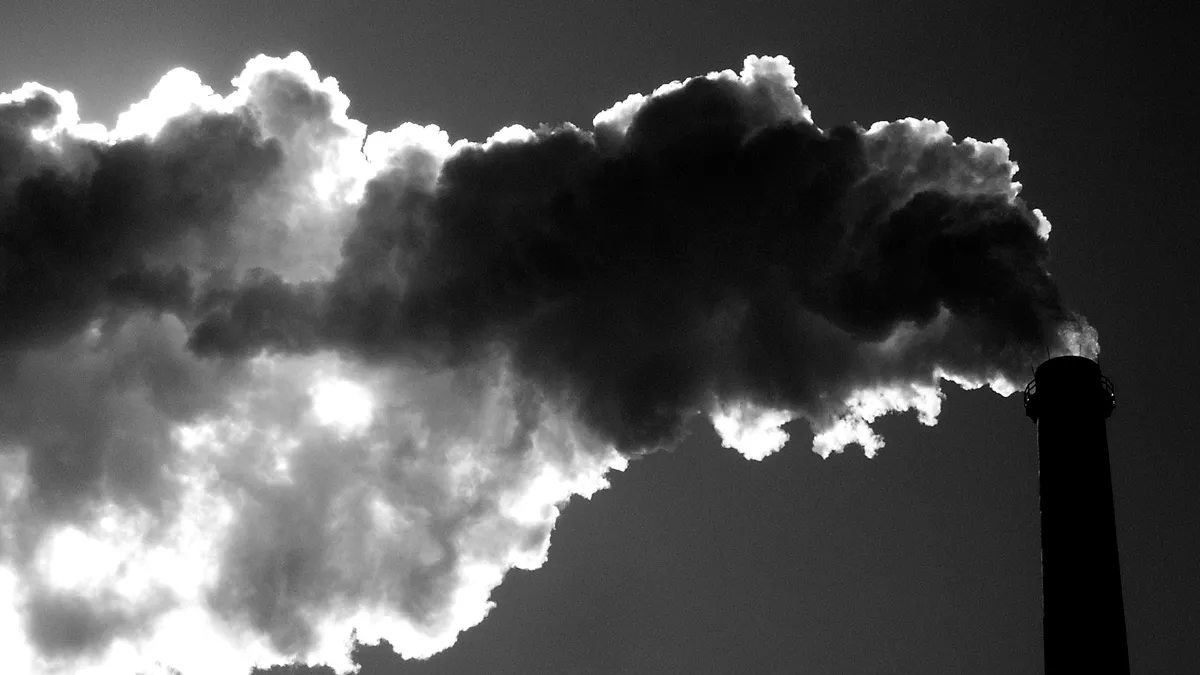The U.S. and its electric power sector are not on track to reduce carbon emissions to the level scientists say is necessary to stave off the worst effects of climate change, according to a new federal government report published Thursday.
The Annual Energy Outlook (AEO), published by the U.S. Energy Information Administration, projects carbon dioxide emissions from the power sector will decrease 9% from 2017 levels by 2050, with fossil fuels continuing to dominate electricity generation.
Economy-wide carbon emissions are expected to decrease 2.5%, with reductions in the power sector and transportation offset by a 16% increase in carbon emissions from industrial sources.
The projections from the Department of Energy's analysis arm put the U.S. far behind schedule to reduce carbon emissions by 80% from 2005 levels by mid-century, the amount targeted for developed economies in the 2015 Paris Accord — an international agreement among more than 180 nations that the Trump administration intends to exit.
Scientists say failure to cut carbon emissions to at least that level will expose the U.S. and other nations to the worst impacts of climate change. By the end of the century, annual economic impacts on some U.S. industries could reach the hundreds of billions of dollars, 13 federal agencies warned in a November report, more than the gross domestic product of many U.S. states.
In the past, EIA has included charts depicting economy-wide carbon emission trends in its AEO reports, but that chart was excluded from the 2019 edition. Instead, an agency official provided Utility Dive with the data for EIA's carbon emission projections via email.
Energy researchers expect the electric power sector to play a vital role in cutting economy-wide carbon emissions, allowing other sectors to wean themselves off fossil fuels through electrification. But the EIA report projects only modest reductions in emissions from the power sector through 2050, as gas and coal continue to make up more than half of the U.S. generation mix, despite renewable energy growth.
Those fossil fuel generators are not expected to install carbon capture and storage (CCS) technologies to mitigate their emissions under current regulations and laws. Even federal tax credits passed last year to boost CCS deployment "do not appear large enough to encourage substantial market penetration of carbon capture in the scenarios modeled," EIA wrote in its report.
EIA projects that 17% of coal-fired generation capacity will retire in its reference case, and more if natural gas prices remain low. But it also expects the remaining plants to run more often, raising their utilization rate and emissions.
The result is a projection that carbon emissions from U.S. electric generators will stagnate in the 2020s. That estimate does not take into account the impacts of the Trump administration's rollbacks of carbon emission rules on power generators and industrial facilities, which energy experts say could raise emissions further, but are not yet finalized.
The moderate emissions reductions from the power sector are expected despite growing deployment of natural gas and renewable resources. After 2020, EIA expects gas and solar to roughly split capacity additions out to 2050.
The wind industry challenges those projections, arguing it will likely continue to add capacity in those decades due to price declines in turbine technology and easier access to financing when federal tax credits expire after the early 2020s.
"EIA's assumption for the learning rate for wind is extremely low," said Michael Goggin, vice president at consultancy Grid Strategies and a former director of research for the American Wind Energy Association. "Basically they treat it as a mature technology like nuclear or coal, whereas PV is treated as a still maturing technology that has significant cost reductions in the future."
In the past, EIA has underestimated growth rates for both wind and solar resources, Goggin noted. But even if those resources outperform the agency's reference case, EIA expects natural gas to add significant capacity as well.
That projected reliance on gas could present problems for carbon reduction efforts, both by crowding out renewable energy deployment and pushing more expensive nuclear plants — which produce carbon-free power — offline. If natural gas prices remain at their current, low prices, EIA projects an additional 24 GW of nuclear capacity closing by 2050.
The EIA report comes weeks after The Rhodium Group, a consultancy, estimated that carbon emissions from the U.S. power sector rose in 2018 after years of decline. The firm credited natural gas with the increase, as utilities ramped up their plants to meet higher electric demand.
That report raised questions about the formula for carbon emissions reductions the U.S. utility sector has used for years — replacing coal plants with natural gas and smaller amounts of renewables. Environmentalists on Thursday said the EIA report adds to those concerns.
"Absent swift and aggressive policy action, we are far from achieving the carbon reductions needed to curtail climate change," Steve Clemmer, director of energy research at the Union of Concerned Scientists, said in an emailed statement.
Clemmer also questioned EIA's exclusion of an economy-wide chart for carbon projections. EIA did not respond to requests for comment on why the chart was not included.
"Notably, in my 20-plus years of looking at the EIA's annual report, thisis the first time I've seen the national report not include projections for total energy-related carbon dioxide emissions in the U.S.," he wrote. "From a climate perspective, it's critical to know how many tons are being released and how much we need to reduce emissions over time. While this data is available online, it begs the question of why the EIA left this essential information out."





















